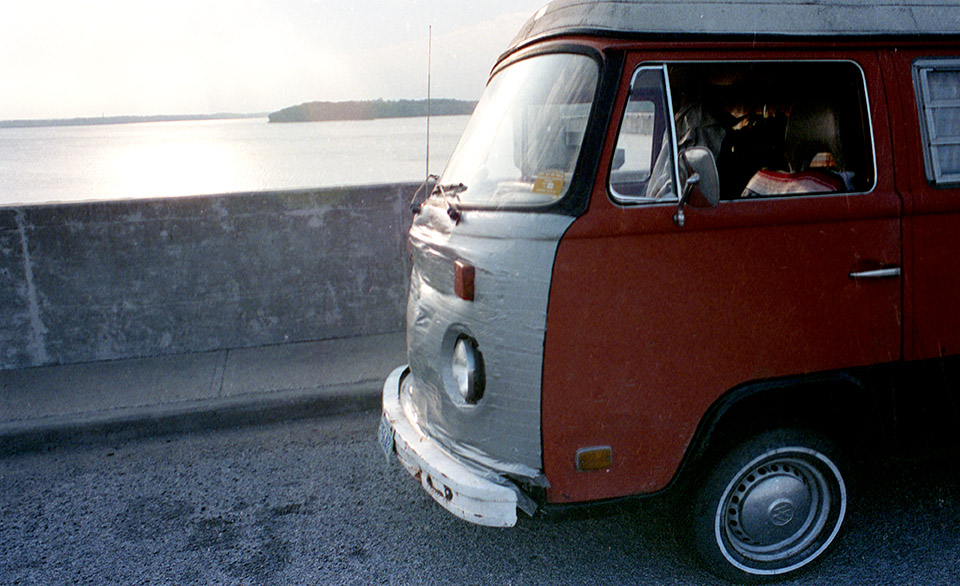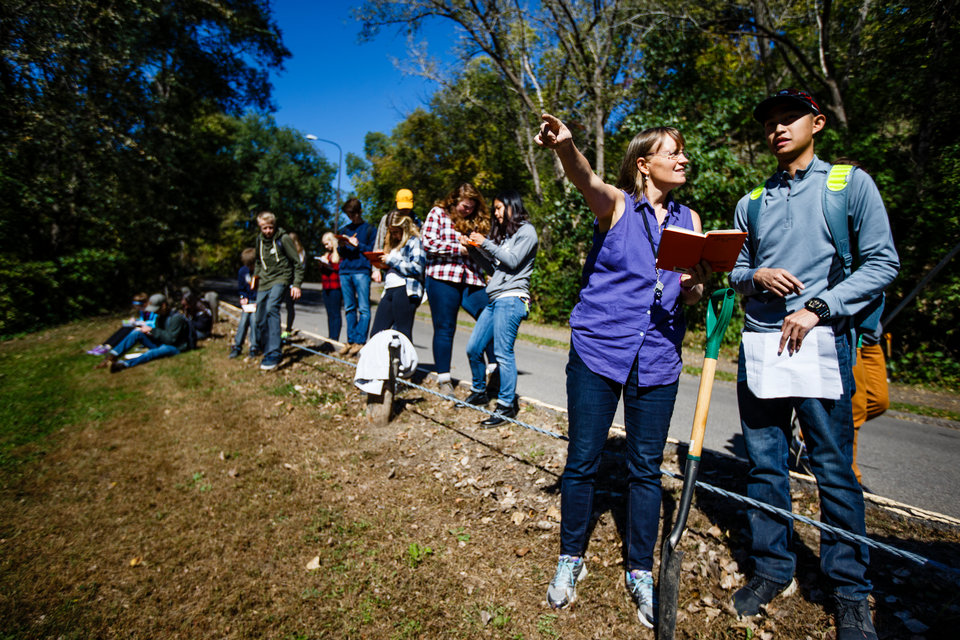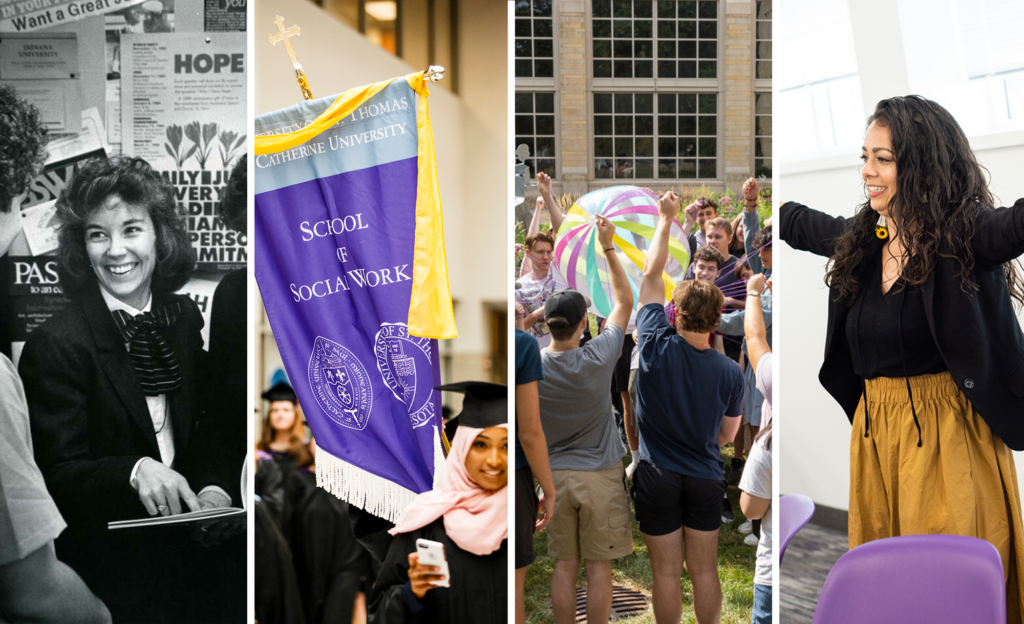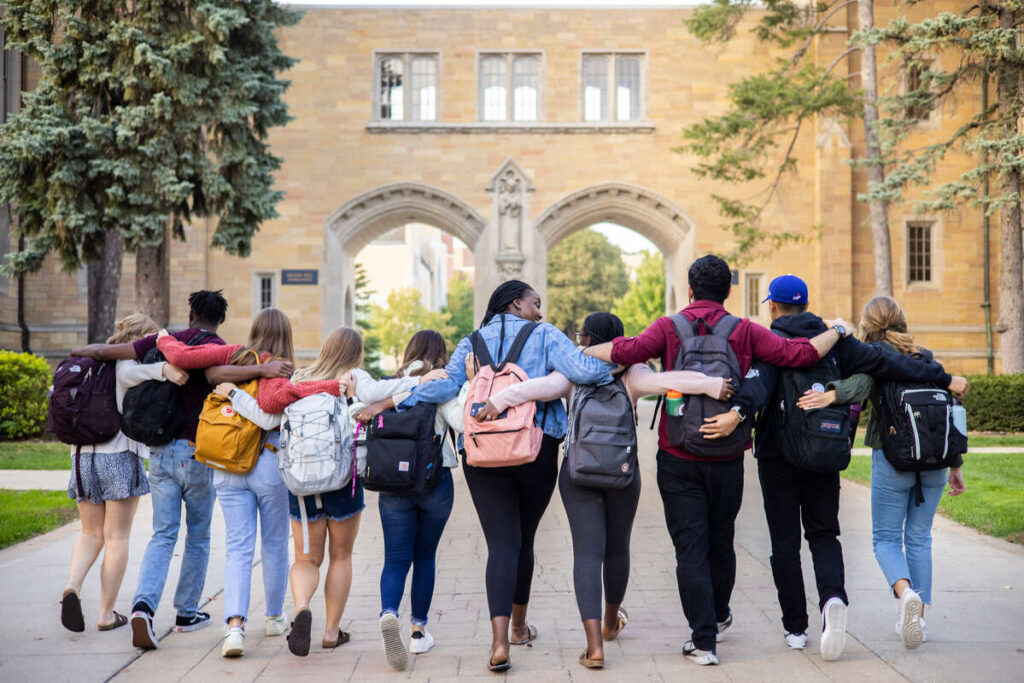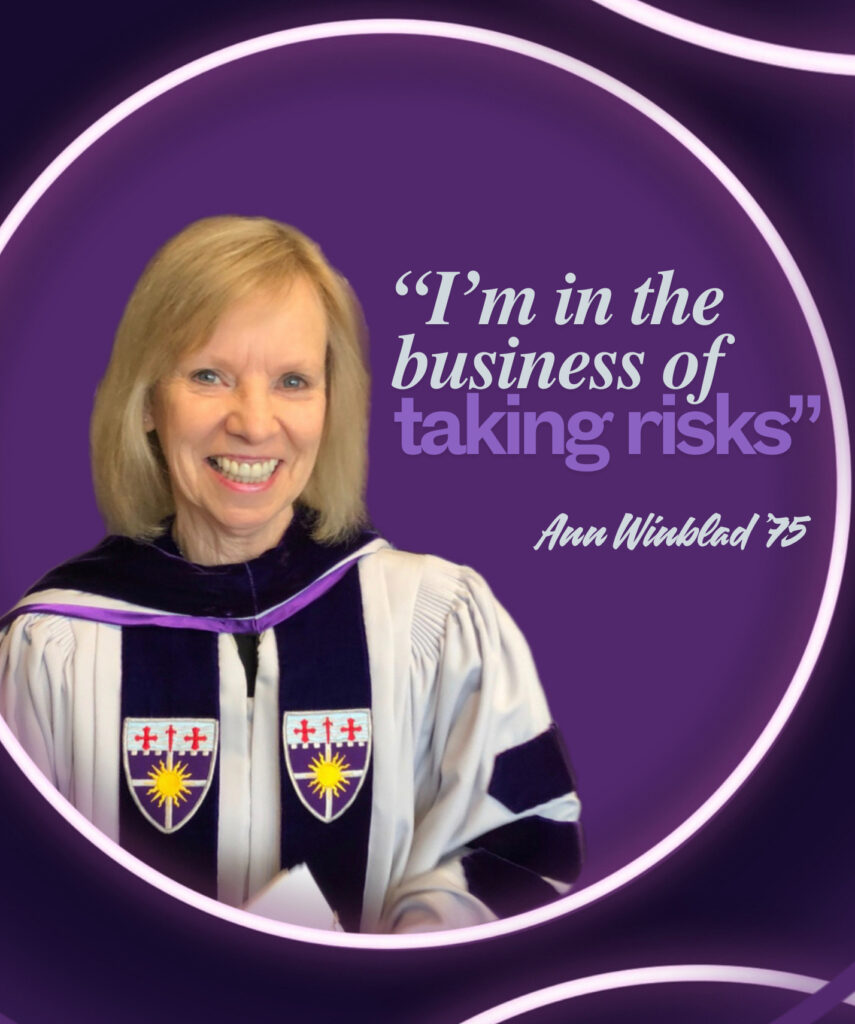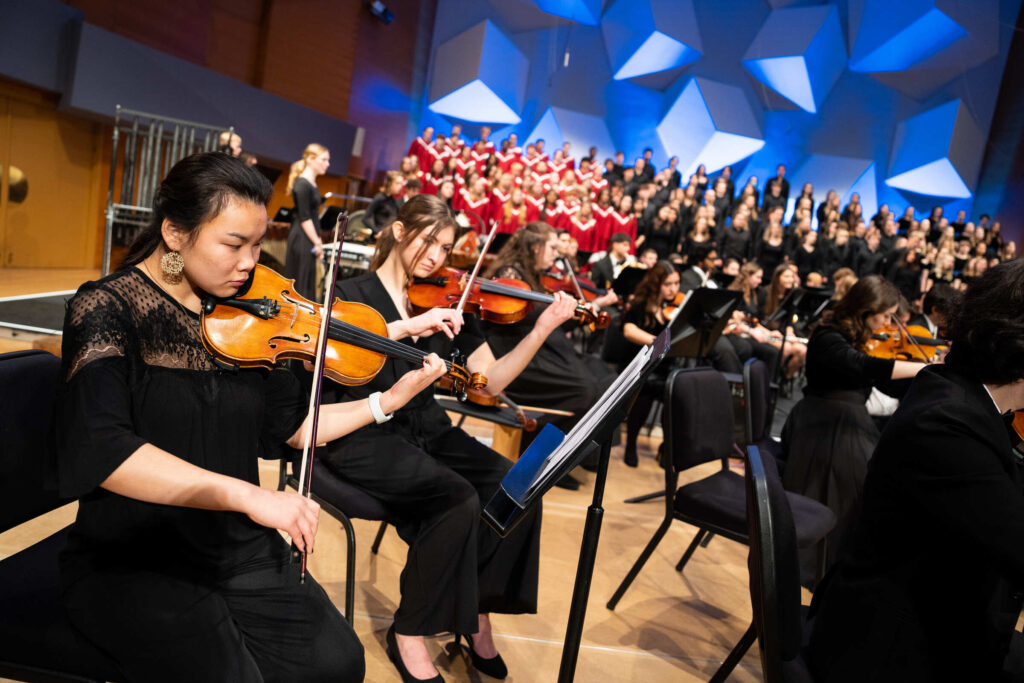This story starts with a 1972 orange Volkswagen camper bus and a $167 scholarship.
Or at least that’s where I thought this story started when Kelly Sardon-Garrity ’91 described his cross-country odyssey that began shortly after he graduated from St. Thomas.
Sardon-Garrity was standing behind me in line at a dinner last October for St. Thomas’ Jay Phillips Center for Interfaith Learning, and we struck up a conversation about our shared experience of studying journalism at St. Thomas. Shared courses. Shared professors. A couple decades makes less difference than you would think.
Through more conversations with Sardon-Garrity, his friend Will Berkovitz ’91 and their former professor Tom Connery, I began to understand just how far this story has come. How far both Sardon-Garrity and Berkovitz have come in recognizing what they were capable of and where they fit into the world. And how far they still have to go. That story goes well beyond a camper bus and $167.
But trust me. We’ll get back to that.
Young Tommies
Sardon-Garrity and Berkovitz met at St. Thomas in the late 1980s. Both born and raised in Minnesota, they grew in friendship as they discussed ideas about life and sought out meaning about where their place was in the world and what they were meant to do.
“Will and I would meet up with other friends, and would come up with all these different theories about life,” Sardon-Garrity said. “We would laugh – even at the time – trying to make these realizations about how life works and how people are. There were endless conversations.”
“I was fortunate to run across Kelly at an important time,” Berkovitz said. “He was searching for the same kinds of things I was thinking about.”

Berkovitz (left) and Sardon-Garrity
Their search acquired a new framework as they took Connery’s literary journalism class in spring 1991. Connery, long noted as a leading voice on literary journalism, or “new journalism” as it was often referred to, helped both young men find meaning in the process of “realizing” others by introducing them to authors such as Joan Didion and Stephen Crane.
“Both Kelly and Will recognized, because they were searching for something like this when they came into literary journalism, that the best literary journalists humanize their subjects,” Connery said. “I’ve made a case that much, if not all, of literary journalism becomes a way to bear witness.
“You’re not bearing witness to tragedy, death or decay, but you’re bearing witness to the humanity of the people you’re writing about,” Connery said. “You’re calling their humanity into existence, because nobody has done this, or rarely: depicted them as human beings. People with the same kinds of wants, needs, emotions, senses of humor. They’re not these stereotypes out there with a narrow range of behavior; they’re fully developed human beings.”
Those ideas rang deeply with Sardon-Garrity and Berkovitz.
“It fundamentally influenced how I am in the world,” Berkovitz said. “He was teaching us, ‘How do you look at the world? What do you see?’ Literary journalism is not a superficial view of things. ... It’s a view of, ‘What does it mean to be alive?’ That has motivated me personally, forever.”
It also helped give new meaning to a profound experience they had together the previous January, when they went on a monthlong VISION mission trip to Jamaica. There they met and interacted with many people, especially young women, whose lives were marked by unfair circumstances and hardships.
“I learned so much about how different my life was from theirs. No kid should have to struggle with what they do. They have a right to have a safe home environment, community, basic things like clean water and food. It was striking to me because that’s not what you find (where I grew up) in Plymouth ... but even there, there are a lot of people struggling,” Sardon- Garrity said.
Throughout that experience and in Connery’s class, Berkovitz and Sardon-Garrity explored more deeply the power of asking questions of people and finding out who they truly are. During a spring break mission trip to Davenport, Iowa, while he was in Connery’s class, Sardon-Garrity connected with a homeless man, John, at the group’s work site and bonded with him over the week.
“Toward the end of the week I remember breaking down with the group because I had so many emotions and thoughts, guilt and shame. I wanted there to be some opportunity for this person, to have him have some hope. My own discernment started coming in, thinking I need to do something with my life so people don’t have to suffer like this,” Sardon-Garrity said. “He highlighted for me the humanity and dignity of each person. The idea that there’s a treasure within each person that wants to be expressed in some way, or known. If we don’t learn to see that, to appreciate it, to ask the questions that can free it, we miss out on that humanity.”
Into the wild
As graduation drew closer, Sardon-Garrity desired to continue seeking people out and – as Connery described – “witnessing” them. Berkovitz would not graduate until the following winter, but Sardon-Garrity had an opportunity to get started without him.
Now, about that 1972 orange Volkswagen camper bus.
Sardon-Garrity had applied for and received a $500 scholarship from an independent filmmaker who had traveled the country in that same bus documenting The Beat Generation, a movement born of several authors’ works throughout the 1950s. When Sardon-Garrity showed up at the man’s house, the scholarship had mostly evaporated and the bus was parked in the middle of a rural Minnesota cornfield, unused for years.

“There were some nests where mice had been living. A couple Playboys; clearly some people had been hanging out there over the years,” Sardon-Garrity recalled. “He was tickled by the idea we could revive this old bus that had sat through 10 Minnesota winters. He was handy and got it going.
“It was rusted out; you could see the pavement as you were going 45 miles per hour on the freeway, which was like the max,” he fondly remembered before cataloging some of the additional “flavor” of the VW. There was a “huge crack in the windshield through our line of vision. The whole front end was smashed and then kicked back out. (The owner) had parked on a hill in San Francisco and the parking brake went. He suggested duct taping the front, so we did, with silver duct tape. Will’s dad ... got some electricity and rigged it with a heater to cut some of the cold wind coming through. It had this huge bulge in one of the tires waiting to pop.
“My parents must have been like, ‘What is this kid doing?’ I didn’t see any of that. I just had to go.”
And so he did, meeting people all over the western states and struggling to keep the old vehicle running. When it wouldn’t, he would hitchhike. With little money, he relied on meeting people to make the situation work everywhere he went.
“I would come alive again in these connections. ‘Wow, this worked out.’ There were many moments like that,” he said. “And there were so many characters.”
The itinerant farmer – fresh out of jail and chasing work with the seasons – who picked Sardon-Garrity up as he hitchhiked. The recovering alcoholic priest with whom he developed a strong bond. The farmer who had been in a car accident and brought Sardon-Garrity all over Nebraska, introducing him to his friends and acquaintances. The professor researching sorghum.
The independent slaughterhouse owner who dispatched his pigs with a .22 rifle.
Eventually, Sardon-Garrity abandoned the sickly orange bus in Colorado and hitchhiked his way through the mountains, settling for about a month in Beaver Creek while working and skiing the slopes. Soon afterward Berkovitz joined him and – in Berkovitz’s Acura Integra – they continued their journey of witnessing people.
“The things we were talking about in college, those were the same questions we brought. We didn’t even know where we were going; we were just going,” Berkovitz said. “We had both studied overseas, gone to St. Thomas, but we didn’t know our own country. Who were the people there? Coming out of that literary journalism bent ... it gave us a framework to begin that exploration.”
Two paths in the same direction
The pair wound their way to the Pacific Northwest, still intending to continue to Alaska, reminiscent of Jon Krakauer’s classic Into the Wild.
“I was going to work on fishing boats and fight fires,” Berkovitz said.
Instead, they stopped in Seattle. (“Have you ever been to Seattle in the spring?” Berkovitz said when asked why.) They lived there together, wrote for newspapers and magazines, and continued to ruminate on where they belonged.
After a few years Sardon-Garrity became disenchanted with the nature of publishing and traveled to St. Louis to take pre-med classes at Washington University. A priest there offered him a part-time position to start coordinating mission programs for students.
“It’s so interesting how life works,” he said. “I was so focused on these classes ... so I studied a lot, but in my midst was starting up a VISION-like program for Washington University students. That became what I loved.”
In helping students experience some of the same things he did – traveling, meeting people outside of his own world, recognizing and valuing their humanity – Sardon-Garrity found his own answers to those questions he traces back to his St. Thomas years. After Washington University he worked for 11 years at Boston College, organizing VISION-like trips for students there and continuing his own education in theology and ministry. Today, he is back at St. Thomas as a program manager for the Office of Civic Engagement, helping organize opportunities for students to impact their communities.
“All of that has allowed me access into something that feels real and true. People have been so vulnerable in sharing who they are with me and allowing me to witness it,” he said.

Sardon-Garrity works on with rancher Pom Ainsley in Colorado.
Meanwhile, Berkovitz’s journey took him back to Minnesota, then to Oregon, Israel and finally to Los Angeles, where he became a rabbi at Ziegler School of Rabbinic Studies. Today he is the CEO of Jewish Family Service in Seattle, a nonprofit with a mission to “help vulnerable individuals and families in the Puget Sound region achieve well-being, health and stability.” He continues to write and find meaning in asking the same questions he and Sardon-Garrity set out to find answers to all those years ago.
“The same things we were pondering then, those things are what motivate me today,” Berkovitz said. “This is all the continuation of that same journey we started on together. If you look at what he does and what I do, they’re totally parallel. We’re doing the same work in the world; it just looks a little different.”
Distance and time have taken the two men from the same campus, cars and cities that they journeyed through together in the past. Their understanding of their places in the world, though, has continued to bridge their lives and the people they interact with every day.
“I love doing this kind of work with students because it’s helping them create meaning in their own lives in a way that’s unique to them,” Sardon-Garrity said. “The main hope is that they’re thinking about that meaning, being cognizant of it and taking opportunities to help them shape that.”
From St. Thomas to that Volkswagen bus to the open road to now, Sardon-Garrity and Berkovitz’s journeys continue. In looking back on the whole odyssey they can see their twisting paths led exactly to where they were meant to go.
“When I was walking forward (on a recent hiking trip near Seattle) I couldn’t even tell where the trail was half the time, but I looked back and the trail was totally obvious,” Berkovitz said.
“Life is kind of like that: Looking back you can see the path you were on the whole time, very laid out, and you didn’t even know it. You’re right where you’re supposed to be.
Read more from St. Thomas magazine.
